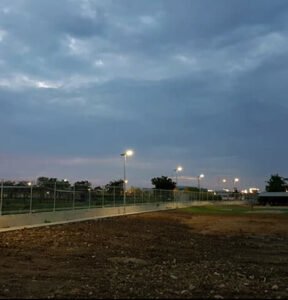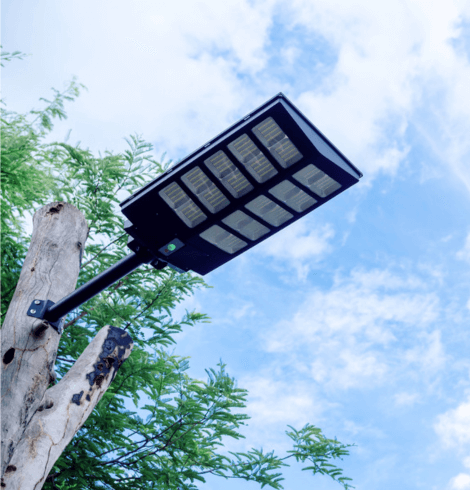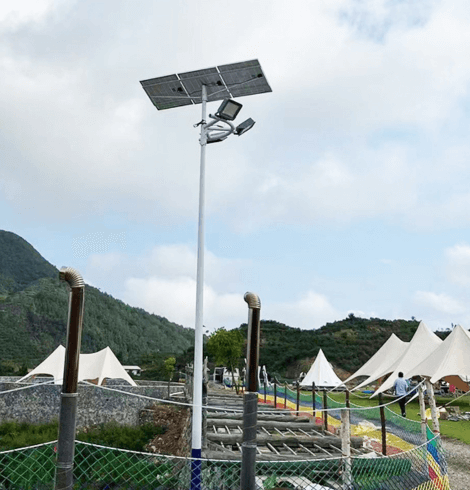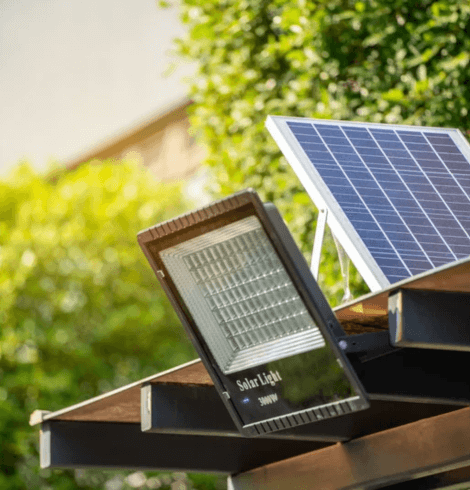Quick Answer First
A solar street light typically consumes between 10 to 80 watts, depending on its use case. For quiet residential paths, 10 to 20 watts might be enough. But when it comes to highways or industrial zones, you’re likely looking at 60 watts or more.
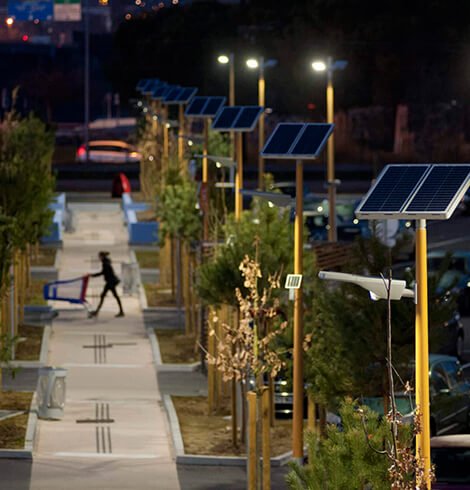
The beauty is, unlike traditional street lights, these solar-powered systems don’t pull energy from the grid. They generate their own electricity from sunlight, store it in batteries, and use it at night to power efficient LED lights.
But where does that energy go? And what determines how much is needed? Let’s walk through the system — not in isolated pieces, but as an integrated whole.
Table of Contents
ToggleWhat Uses Power in a Solar Street Light?
To really understand energy use, it helps to open the system up and look at the key players inside — the ones consuming power, managing it, and stretching it as far as possible.
The LED Lamp: The Primary Power Draw
The biggest consumer, unsurprisingly, is the LED lamp. It’s the part that lights your street, and it’s also where most of the power goes.

A 30-watt LED running for 10 hours uses 300 watt-hours of energy. On highways, higher-powered LEDs — sometimes 60 watts or more — are common.
Fortunately, LEDs are very efficient, converting energy into light much better than older technologies like sodium vapor or metal halide lamps.
The Solar Charge Controller: The System’s Brain
Just behind the scenes is the solar charge controller, the system’s decision-maker. It determines when to charge, when to discharge, and how to protect the battery from overuse.
It doesn’t consume much energy itself, but it plays a vital role in managing the flow — think of it as the light’s brain.
Sensors in Solar Street Lights: Do They Use Power?
And then there are the sensors. They might not seem important at first glance, but motion sensors, daylight detectors, and timers allow the system to dim when no one’s around and brighten up only when needed.
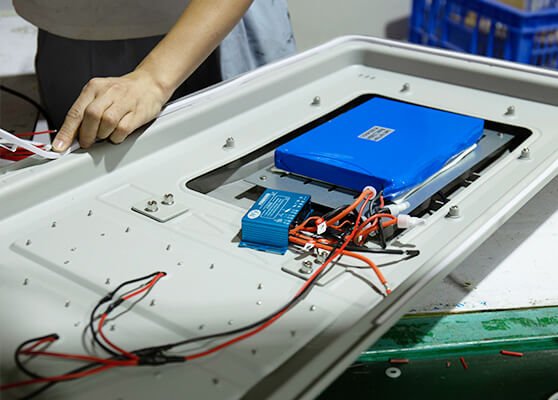
While their power draw is minimal, their impact on total energy usage can be huge.
Now that we’ve covered where the energy goes, the next question is: what causes some systems to use more energy than others? Let’s connect the dots.
What Affects Solar Street Light Power Consumption?
Power consumption isn’t just about how bright the light is. In reality, it’s shaped by a combination of smart design choices and environmental realities — all of which can dramatically affect how much energy the system needs to draw each day.
How Wattage and Lumens Affect Solar Light Energy Use
It starts with LED wattage and brightness. Higher wattage means brighter light — but also more demand on your battery and solar panel.
A 20-watt system might be perfect for a neighborhood street, while a 70-watt setup might be necessary for lighting a wide highway or large parking lot.
The Impact of Dimming and Lighting Schedules on Energy Use
But wattage alone doesn’t tell the whole story. How long the light stays on — and whether it dims during the night — has a major influence.
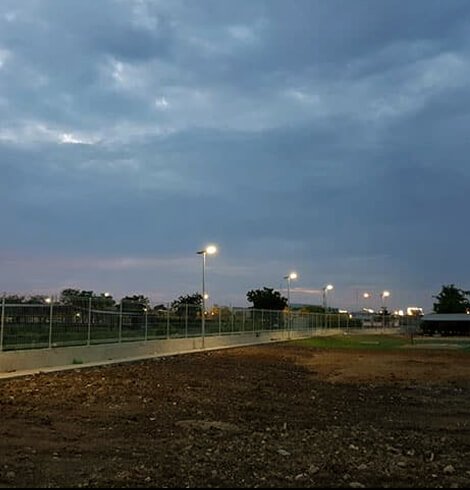
Systems that use dimming schedules or motion-based lighting can reduce their average daily power consumption by up to 50%. Instead of running at full brightness all night, many lights are programmed to dim during the quietest hours, reserving full power only when it’s needed.
How Location and Sunlight Hours Affect Solar Panel Sizing
Then there’s the sun — or more precisely, how much of it your location gets.
A solar light in Florida gets a very different amount of sunlight than one in Scotland. Fewer sun hours mean the system needs a larger solar panel and battery to provide the same output. And in cloudy or rainy seasons, those design choices become even more critical.
How Energy Efficiency Affects the Total Power You Need
Finally, system efficiency ties everything together. Every time energy is converted — from sunlight to electricity, from battery storage to LED output — a little bit is lost.
Even high-quality systems have efficiency losses of 20–30% across the entire energy chain. That’s why you can’t just calculate how much power the LED needs — you also have to account for what’s lost along the way.
No system is 100% efficient. Losses happen in:
- Solar panel conversion (typically ~18–22%)
- Battery charging/discharging (~85–90%)
- LED driver (~90–95%)
Knowing this helps size the system realistically. If your light uses 30 Wh/day, the panel must supply slightly more to account for these losses — maybe 35–40 Wh/day.
So with all these moving parts, how do you figure out what size your solar light needs to be? That’s where a bit of math comes in — and don’t worry, I’ll walk you through it.
How to Size a Solar Street Light?
Let’s imagine you’re building or evaluating a solar street light. Whether it’s for a sidewalk, a parking lot, or a highway — the calculation steps are the same. You just adjust the numbers to match your real-world needs.
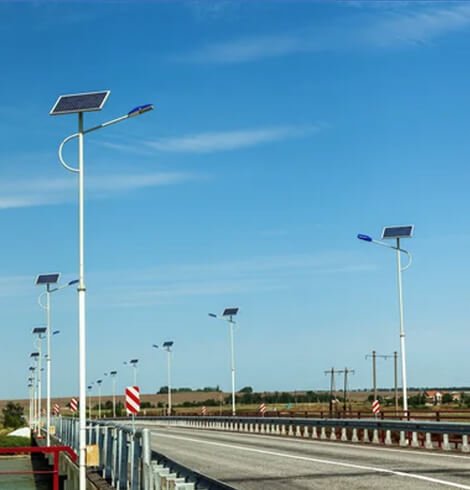
Step 1: Estimate How Much Energy Your Solar Light Uses Daily
The first thing you need is the daily energy load — how much electricity your light consumes each night.
Example:
- 30W LED running for 10 hours per night
= 30 × 10 = 300 watt-hours (Wh) needed per day
If you have a 30-watt LED running for 10 hours, that’s 300 watt-hours (Wh). If you use dimming and the average draw drops to 20 watts, you’re looking at 200 Wh per night. Simple enough.
Step 2: Choose the Right Battery Size for 2–3 Days Backup
Once you know that, you need to size the battery. Batteries should not just cover one night — they need to survive cloudy days too. This is called battery autonomy.
If you want 2 days of backup:
- 200 Wh/day × 2 days = 400 Wh battery
For a 12V system:
400 Wh ÷ 12V = 33.3 Ah battery
Most systems aim for 2 to 3 days of autonomy. So if you need 200 Wh per day and want 2 days of backup, you need at least 400 Wh of battery storage.
Divide that by the voltage of the system — say 12V — and you get about 33 amp-hours. To be safe, round up. A 40Ah lithium battery would be a smart choice here.
Step 3: How to Pick a Solar Panel Based on Sunlight Hours
Now you figure out the solar panel size. Your panel needs to produce the full day’s energy in the few hours of direct sunlight you get. If you need 200 Wh and get 5 peak sun hours, then a 40W panel could theoretically do the job.
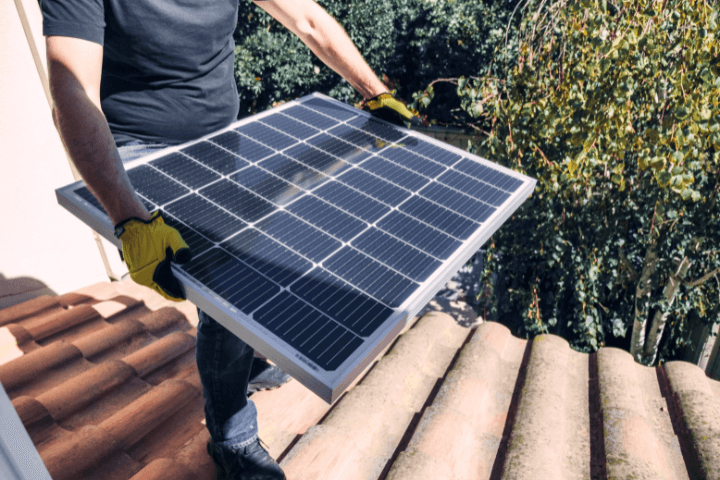
Assume:
- You need to produce 200 Wh/day
- Location gets 5 peak sun hours/day
So:
- 200 Wh ÷ 5 hours = 40W panel needed
But accounting for energy losses (charging efficiency, cloudy days, etc.), you’ll want to bump that up by at least 30%. That puts you closer to a 60-watt or even 80-watt panel, especially if reliability is a concern.
And just like that, you’ve gone from “how many watts does this light use?” to designing a complete solar lighting system. But let’s step back and put all this into context.
Final Thoughts
A solar street light isn’t just a fancy lamp with a panel on top. It’s a self-contained, energy-efficient micro-system that takes in energy during the day and gives it back at night — all without touching the grid.

The amount of power it uses might sound modest — 10, 30, or even 80 watts. But behind those numbers is a chain of smart engineering: LEDs that sip energy instead of guzzling it, batteries that hold just enough charge to make it through cloudy nights, and control systems that adjust brightness based on real-world conditions. It’s this delicate balance that makes solar street lighting both reliable and sustainable.
When designed properly, solar lights don’t just save on electricity costs — they work anywhere, survive blackouts, and reduce the need for complex underground wiring. And best of all? They do all this using nothing but sunlight.
FAQs
What’s the typical wattage of a solar street light?
Anywhere from 10 watts for a small pathway to 80+ watts for major roads. The LED power depends on how much brightness is needed.
Does it use any grid electricity?
Not at all. It’s fully powered by the sun — stored in a battery during the day, used at night.
How long can they run at night?
Most are designed to run 8 to 12 hours, with smart dimming in the later hours to conserve power.
Will it still work on cloudy days?
Yes, if the system is designed correctly. Batteries typically store enough for 2–3 nights. But in low-sun regions, systems must be sized accordingly.
Can I install the same system anywhere?
Not quite. Solar street lights need to be tailored to the local sun hours, climate, and application. One size rarely fits all.



